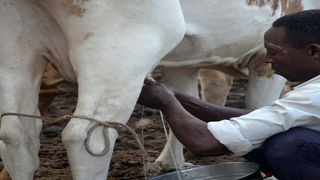
Raw milk production has been growing over the years. Photo| Edgar R Batte
|Commodities
Prime
Annual milk production rises to 2.81 billion litres
What you need to know:
- Whereas milk production continues to grow, consumption remain low, standing way below WHO’s recommended per capital of 200 litres.
Milk production increased to 2.81 billion litres in the period ended July 2021, according to a report by the Dairy Development Authority (DDA).
However, the increase was lower than three billion litres that DDA had projected during the period.
According to the report, during the period, milk production increased by 210 million litres, growing from 2.6 billion in the same period ended July 2020 to 2.81 billion litres.
Milk production has tremendously increased over the last seven years, growing by 74 percent from 2.08 billion in 2015 to 2.81 billion, according to DDA data.
However, on average only 30 percent of the total annual production is processed, which means that there is a lot of wastage and low levels of value addition.
During the period under review, according to DDA, processing plants (large, medium, small and cottages) increased from 100 with installed processing capacity of 2.7 million litres in 2018 to 116 in 2021 with estimated total processing capacity of 3.1 million litres.
“This increment is contributed by dairy cottages in south west and central milk sheds adding value to the milk as the sector strives to reduce post-harvest loss, improve milk marketing and create jobs along the dairy value chain,” the report reads in part.
During the period, the report noted, dairy exports had reached Shs358.6b in the last four years, contributing at least 42 percent to total agricultural exports.
The growth, the report indicates, almost doubled what was produced in same period in 2020 due to strong emphasis on compliance to international standards and penetration of new markets such as Algeria, among others.
Milk products worth Shs12.1b were imported, while dairy equipment worth Shs18.9b, which included machinery, parts of milking machines and dairy machinery, milking machines, refrigerating and freezing equipment, among others were imported to support milk processing.
Mr Michael Kansiime, the DDA executive director, noted in the report that whereas there was growth recorded in the last two years, Covid-19 had presented a number of challenges but projections were at the same time exciting, promising to deliver better results going forward.
Milk consumption in Uganda remains low with a per capita consumption standing at 62 litres per person against World Health Organisation recommended consumption of 200 litres.
However, consumption, according to DDA is expected to slightly increase to approximately 65 litres in the short term due to rapid urbanisation and other consumption campaigns such as the School Milk Programme.
Jesa Farm Dairy seeks to expand
Meanwhile, Jesa Farm Dairy has said expansion works at its plant, which seek to increase production capacity across its products range, are nearing completion, noting that everything is being done to limit disruption on production.
Speaking during a site status visit at the weekend, Mr Tunga Musorowegomo, the Jesa project manager in-charge of the expansion, said that whereas such large scale capacity expansion projects have a potential to disrupt production, it was important to prepare ground for future growth in demand as witnessed in the last few years.
“Usually, there is a level of disruption because we must move equipment and machines, install and commission new ones and this process may take several weeks. However, the increased capacity more than compensates for the short interruption,” he said, noting that concerns over supply of milk across the industry has been due to delay of the rain season and a sharp spike in consumption occasioned by lifting of Covid -19 related lockdown.
Mr Dennis Sibanda, the Jesa Dairy plant manager, said expansion works had disrupted supply of yoghurt and flavored milk products but noted everything was being done to have them back on the market as soon as possible.
“We have seen a constant rise in consumption and consequently demand ... and as such we know there will be pressure. However, it’s important to let our consumers know that the expansion that is happening will ensure that the market is sufficiently stocked with quality products,” he said.




